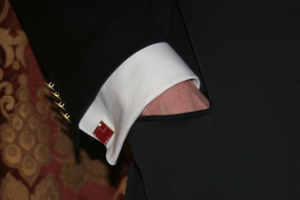A magazine where the digital world meets the real world.
On the web
- Home
- Browse by date
- Browse by topic
- Enter the maze
- Follow our blog
- Follow us on Twitter
- Resources for teachers
- Subscribe
In print
What is cs4fn?
- About us
- Contact us
- Partners
- Privacy and cookies
- Copyright and contributions
- Links to other fun sites
- Complete our questionnaire, give us feedback
Search:
The Tactful Watch
These days art and high technology don't mix much. Personal gadgets are one thing, jewellery quite another. That hasn't always been the case though and hopefully it won't be in the future.
In the 18th century there was a mobile revolution just like the current one. Back then the technology wasn't the MP3 player but the pocket watch. The 18th century watchmakers weren't just innovators though they were also artists and craftsmen. The result was truly exquisite jewellery that was also highly functional.

One of the absolute masters was Abraham Louis Breguet. Born in Switzerland, he set up business in Paris and was to become one of the greatest innovators ever. His clients included the likes of Marie-Antoinette, King George IV of Britain, the Sultan of the Ottoman Empire and the Tsar Alexander I of Russia. Rather than build lots of identical watches he constantly tinkered with the designs. The result was that he is responsible for some of the most important innovations in clock technology. Many of his inventions were technical advances such as the first self-winding watch. He realised the importance of making his designs easy to use too though. A Breguet watch, made for the Queen of Naples, for example, was the first to be worn on the wrist!
In the 21st century we are just getting to grips with new ways of interacting with our personal gadgets. People have realised that basing mobile device designs on what works for a desktop PC is not so sensible. When on the move it's not that convenient to have to look at a screen. Consequentially we are undergoing a revolution in multimodal computing. It involves finding ways of using our other senses not just sight to interact with computers. The way your phone vibrates in your pocket is one simple example - tactile computing, delivering information through your sense of touch.
Clever as we are Breguet was way ahead of us though. At the turn of the 18th century it was not considered polite to look at your watch in public. Breguet's solution was the tact watch: a watch that allowed you to check the time without taking it out of your pocket. Tactile and tactful computing! His solution was of course (in all senses) incredibly elegant.
Round the edge were 12 evenly spaced diamond studs, with larger ones at the 3, 6, 9 and 12 positions. On the outside was an arrow. It did not move on its own like a normal clock hand, though. That wouldn't really work inside a pocket without a glass case and then it couldn't be touched. Hidden inside the case was an actual clock. When the owner wanted to tactfully check the time they would just spin the arrow until they felt resistance. That meant the arrow was now back in synchrony with the real hour hand. They could then count round the diamond studs to work out its position and so the time.
One of the most stunningly beautiful tact watches was made for Josephine Bonaparte, Empress of France in 1800. Two centuries later it sold at Chrysties for over $1.3 million.. The best we seem to be able to do in the 21st century is to just dip an iPod in gold and coat it with diamonds. The result: not 18th century elegance, just very expensive 21st century bling.
Artists and jewellers are starting to work with scientists and engineers again though so maybe our modern gadgets can follow the path of the watch and become elegant jewellery too.


